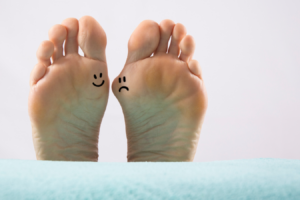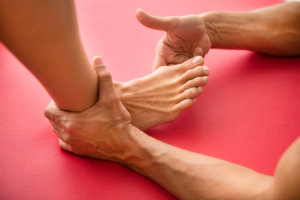 Have you ever experienced a painful, bony bump on the outside of your big toe? If so, you may have a bunion – a condition that impacts 1 in 3 Americans. In this post, we’ll explain what bunions are and discuss their causes, symptoms, and treatment options. Read on to learn more about bunions.
Have you ever experienced a painful, bony bump on the outside of your big toe? If so, you may have a bunion – a condition that impacts 1 in 3 Americans. In this post, we’ll explain what bunions are and discuss their causes, symptoms, and treatment options. Read on to learn more about bunions.
What are bunions?
For starters, a bunion (also referred to as hallux valgus) is a typically-painful, bony bump that develops on the inside of the foot at the big toe joint. Bunions develop slowly. Often, they form after years of pressure on the big toe when the metatarsals and phalanges (foot bones) get out of alignment, causing the bones to become deformed.
Fun fact: Interestingly, the word “bunion” comes from the Greek word for turnip. This is an appropriate name because the bump on the inside of the foot typically looks red and swollen like a turnip.
Are bunions and bone spurs the same thing?
No, bunions and bone spurs are not the same things. Bone spurs are an extra growth of bone around a joint and are often a result of the body trying to make up for missing or broken-down cartilage.
What are the symptoms of bunions?
The primary symptoms of bunions include bone deformity, pain, redness, and stiffness. Bunions can also cause tenderness, numbness, hardened skin on the bottom of the foot, and a callus or corn on the bump. Additionally, the bunion may cause difficulty walking due to stiffness and restricted motion in the big toe.
What causes bunions?
First, bunions are more common in older adults, especially women. Often, this is because women tend to wear high heels or pointy and narrow shoes, which force the foot into unnatural formations causing misalignment. Also, because a bunion is formed when the big toe pushes against the next toe, bunions may be caused by:
- Wearing shoes that don’t fit properly. Specifically, shoes with a narrow, pointed toe section that forces the toes into an unnatural position can cause bunions.
- Genetics. Some people are more likely to develop bunions because of the foot shape and structure they inherited.
- Having an inflammatory condition. Inflammatory conditions, like rheumatoid arthritis or a neuromuscular condition such as polio, can contribute to the development of bunions.
What happens if a bunion goes untreated?

Unfortunately, if bunions are left untreated they can lead to more issues, including hammertoe, bursitis, and metatarsalgia. Hammertoe is an unnatural bend in the middle of the toe that can add extra pressure to the original bunion. Additionally, bursitis is inflammation in the fluid-filled sac in your joints, and metatarsalgia is pain and swelling in the ball of the foot. By treating a bunion sooner rather than later, patients will save themselves the extra pain that comes with these conditions.
How are bunions treated?
Conservative (Nonsurgical) Bunion Treatments
During the first visit, the physician will most likely order x-rays and conduct a physical exam on the foot to determine where the foot pain is coming from. Then, if it is a bunion, the doctor will typically suggest conservative treatment first. Often, this includes changes in footwear – no high heels or narrow shoes – ensuring there is plenty of room. Also, the doctor may recommend tying your shoes more loosely. Additionally, your doctor might suggest special foot padding or orthotic shoe inserts to help cushion and/or distribute pressure more evenly to keep the bunion from becoming irritated.
 Furthermore, conservative bunion treatment may include an anti-inflammatory medication to reduce pain and swelling. Physical therapy may also help to ease the inflammation on the toe and strengthen the muscles around the bone. But if these initial treatments don’t help, your doctor may recommend a cortisone injection to reduce swelling and inflammation.
Furthermore, conservative bunion treatment may include an anti-inflammatory medication to reduce pain and swelling. Physical therapy may also help to ease the inflammation on the toe and strengthen the muscles around the bone. But if these initial treatments don’t help, your doctor may recommend a cortisone injection to reduce swelling and inflammation.
Bunion Removal Surgery
Thankfully, most bunion pain can be managed successfully with conservative treatment. However, if the swelling and pain don’t improve, surgery might be considered. It is important to note that insurance will only cover this type of surgery if the bunion is proved to interfere with everyday activities – not if the bunion simply looks abnormal.
During bunion surgery, the surgeon will first remove any damaged tissue. Then, they will realign the bones. Finally, they will remove any bone growths caused by cartilage breakdown during the misalignment.
Surgery Recovery.
Depending on the intensity of the surgery, recovery can take anywhere from 3 to 8 weeks. Additionally, you may experience minor pain and swelling that lasts as long as 6 months to a year.
Following bunion removal surgery, proper post-operative care will be imperative. In fact, bunions have a small risk of recurrence if post-operative care is not taken seriously. Physical therapy, wearing shoes that fit correctly, and resting after walking for long periods of time are all important for foot health after surgery. If you’ve had any issues after bunion removal surgery, please make your doctor aware as soon as possible so they can be addressed quickly.
Importantly, those who smoke or have diabetes should also be aware that they may have a higher risk of complications after surgery. The human body needs good blood flow and high oxygen levels to heal well. Smoking limits the oxygen supply throughout the body. Additionally, diabetes can negatively affect blood flow through the feet. So, without proper blood flow, healing may be prolonged or inhibited.
When should I talk to a doctor?
Thankfully, bunions don’t always require special medical treatment. However, if the resulting pain or inflammation impacts your everyday life, consider speaking with a specialist. In fact, you should consult a physician if you experience chronic (ongoing) big toe or foot pain, a bump that is visible on your big toe joint, and/or decreased movement of your big toe or foot.
Call us today at 615.885.0200 to schedule your appointment.

With two locations near Nashville in Mt. Juliet and Hermitage, Advanced Ortho and Spine provides patients with high-quality, personalized care while advancing orthopaedic excellence. Contact us today to learn more or to schedule your appointment.
Disclaimer: This blog provides general information and discussions about health and related subjects. The information and other content provided in this blog, or in any linked materials, are not intended and should not be construed as medical advice, nor is the information a substitute for professional medical expertise or treatment.If you or any other person has a medical concern, you should consult with your healthcare provider or seek other professional medical treatment. Never disregard professional medical advice or delay in seeking it because of something read on this blog or in any linked materials. If you think you may have a medical emergency, call your doctor or emergency services immediately.
The opinions and views expressed on this blog and website have no relation to those of any academic, hospital, health practice, or other institution.